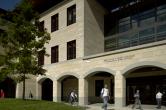Buildings Initiatives
Guidelines for Sustainable Buildings
As described in Stanford's Project Delivery Process (PDP) manual, the university is committed to providing a sustainable and inspiring built environment for its students, faculty, staff, and visitors. At Stanford, sustainability refers to ensuring that buildings not only use energy, water, and other natural resources efficiently, but also provide a safe, productive, and educational environment. Stanford recognizes that the building industry has a tremendous impact on the natural environment, both regionally and globally, and the university has the opportunity to take a leadership role in how buildings can be built to conserve resources and inspire users. This requires an integrated process with sustainability as a base criterion in all development stages.
Stanford’s PDP manual therefore incorporates sustainability through the Guidelines for Life Cycle Cost Analysis, and Stanford's Guidelines for Sustainable Buildings, which adapt the USGBC’s Leadership in Energy and Environmental Design (LEED) system and the US government’s Labs21 guidelines to the university setting, addressing a wide spectrum of qualities across five categories.
Energy and Water Usage Reduction Targets
Stanford set new energy and water reduction targets in 2007. The university augmented these guidelines by establishing new building performance guidelines that target efficiency in new buildings of:
- Energy efficiency 30 percent below California Title 24/ASHRAE 90.1 (2004)
- Water efficiency of 25 percent below similar existing campus buildings
In 2015 the university embraced a new method of benchmarking that allows for a more holistic, and also more rigorous, method for designing high-performance buildings. The university replaced the energy efficiency goal of 30% beyond code with whole-building energy performance targets derived specifically for each new building coming online. The targets are set by comparing the new building to the energy consumption of peer buildings at other California universities, the energy consumption of similar buildings on campus, and its own best possible energy performance. This new method allows Stanford to continuously improve the energy performance of its buildings by incorporating lessons learned into each new project.
Sustainable Architectural Strategies
Conservation standards are achieved through key design strategies that reduce the electricity and heating load of the building and make the interior as resource efficient as possible. The exterior design is a referential but current expression of Stanford context and identity driven by modern construction technology and sustainability. The interior expression is driven by the goals of the program and sustainable performance goals and conveys the identity of the users.
Key strategies in design include:
- Siting: Driven by the Campus Master Plan which encourages a quad with East/West elongation to take advantage of the natural benefits of North/South vs. East/West light; siting is the most important element of design.
- Envelope: Uses an overarching category for façade exposure, high performance building envelope design, advanced glazing technology (different glass specified for each exposure in order to balance daylight penetration with heat loss and gain and exterior), and shading devices to maximize light intake and minimize heat gain.
- Insulation: Extensive envelope analysis/energy model performed to determine the optimal amount of insulation and thermal breaks in window construction in order to maximize insulation capacity.
- Building-level renewable energy: Incorporating renewable power as a part of building design. The university currently has solar demonstration projects at the Leslie Shao-Ming Sun Field Station at Jasper Ridge, Shriram Center, Synergy House, Hoover House, Reservoir 2, the Jerry Yang and Akiko Yamazaki Environment + Energy Building, the Huang Engineering Center, the Center for Nanoscale Science and Engineering, and the new Knight Management Center, plus solar thermal systems at Roth House and Governors Corner.
Space Utilization
Stanford conducts rigorous space utilization studies to renovate existing buildings to create space for new needs. A key goal is to recover 5 to 10 percent of the space in campus buildings. The Department of Capital Planning updated the university’s Space Planning Guidelines in 2006 and is conducting studies to ensure that we add new space only when necessary. Studies have found that offices applying the guidelines could recover up to 10 percent of their space. To encourage more efficient use of office space, Stanford requires selected schools to pay a charge for under-utilized space. Several schools are working to reduce their space charge with efforts such as conducting master space plan studies and renovating spaces in conformance with the Space Planning Guidelines.
Constant Innovation in Building Design and Learning
Internal design guidelines encourage experimentation with new technologies. The University recognizes that not all new buildings will achieve these targets. Stanford engineers and architects transfer information learned through design, construction, and operation of new buildings to subsequent buildings with a goal of achieving these targets in its overall building program. For instance, Y2E2 was the first of four buildings that make up the Science and Engineering Quad. The latter three buildings in this 500,000 square foot development were built, as Stanford President John Hennessy told the Faculty Senate, “to the same level of environmental standards [as Y2E2], so that we can become a leader, not only in research, but in the practice of building new facilities.” The Huang Engineering Center, Spilker Engineering & Applied Sciences, and the Shriram Center have now all been constructed to the same standards or better, completing this pioneering quad.





